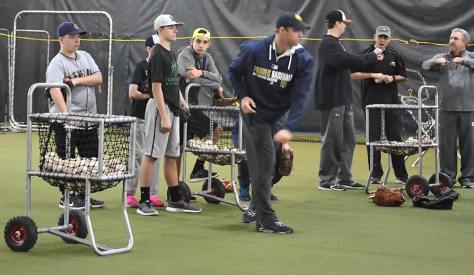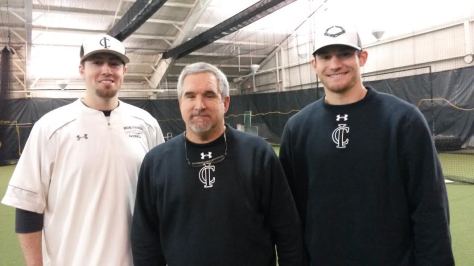
By STEVE KRAH
To pitch at high levels — college or pro — the space between the ears becomes even more important than the arm.
That’s one of the big lessons Eric Stults absorbed in his 14 seasons of professional baseball (2002-2015).
“It’s the mental part of the game,” Stults said after leading a pitching camp for youngsters Saturday, Feb. 25 at Eastlake Chargers Baseball/Softball Academy inside Eastlake Athletic Club in Goshen. “A lot of guys can physically throw a baseball and throw it hard and well. But what separates the guys who excel or do so at the next level is their ability to mentally make adjustments and stay focused.
“It’s somebody I probably didn’t learn until college. More than physically, I needed to be mentally sharp. (After learning that,) I was practicing that as much as I was throwing the baseball.
“The earlier some of these players can get that, it’s only going to help them along the way.”
Stults played at Argos High School and Bethel College before being drafted in 2002. The left-hander’s pro baseball odyssey took him through experiences with five different Major League Baseball clubs (Los Angeles Dodgers, Colorado Rockies, Chicago White Sox, San Diego Padres and Atlanta Braves) as well as several minor league teams and in Japan (Hiroshima Toyo Carp).
While working toward the big leagues (he made his debut in 2006), Stults was introduced to the importance of the mental side.
“I got in a rut and was searching for something,” Stults said. “Someone said, ‘have you ever thought of the mental side of the game?’ I said, ’Not really. I just go out there and throw the baseball and hope for the best.’”
Stults started his Indiana Chargers camp remarks by focusing on enjoyment of the game.
“This is a game,” Stults said to 45 pitchers of varying ages and their parents. “We want to have fun.”
Then comes learning how to pitch — not just throw.
Even the hardest throwers can’t rely on velocity alone.
Stults, who resides in Middlebury, enjoyed longevity in the game not from gas but his ability to focus on the game within the game — pitcher vs. hitter. He was able to change speeds and the eye levels of hitters by moving the ball around.
After a Tommy John surgery early in his career — before he really knew the importance of arm care — he stayed relatively healthy.
While campers went from station to station for Crossover Symmetry Band work for rotator cuff and scapular strengthening, throwing and recovery drills with the help of ECBSA’s Joel Mishler, Justin Barber and George Hofsommer, Stults also took time to tell them about concepts like routine.
Stults, who worked with many coaches and sports psychologists throughout his diamond days, said his routine changed throughout his career, but having one helped with the mental side of the game.
One pre-pitch routine that he had was taking a deep breath and letting it go along with all of the tension.
“It can be that simple,” Stults said. “I also had a key word — FOCUS. It let me focus on the catcher’s glove and take the distractions out of my head. That allows you to get back into a good mind frame.”
Learning the mental side also helped Stults to keep from dwelling on the negative things and focus on his next pitch or next outing.
“The mindset is you’ve got to forget about it,” Stults said. “It’s easier said than done. But that comes through practice and mental part of the game. Let’s move forward.”
In discussing mechanics, Stults noted that not everyone delivers the ball in the same way or has the same arm slot.
“As an individual, you have to figure out what works for you,” Stults said. “When I talk about different grips and throwing different pitches, it’s trial and error.
“You have to be willing to try new things and be coachable.”
Stults encouraged players to learn how to “self-coach” and diagnose their own problems and find solutions.
He emphasized always having a purpose even when playing catch (throw to a target) and developing tempo and rhythm while using nice loose grip on the baseball.
As Stults, 37, looks back on his lengthy career, it’s the relationships that stand out.
“What was gratifying was the people I met,” Stults said. “You can sit there and talk about victories and this and that. But it’s the people I met along the way. It’s that clubhouse camaraderie I was able to have in baseball.”

Former big leaguer Eric Stults demonstrates a grip during a camp at Eastlake Chargers Baseball/Softball Academy inside Eastlake Athletic Club in Goshen. (Photo By John Sadowey)

Eric Stults throws at a camp at Eastlake Chargers Baseball/Softball Academy in Goshen. He was helped by ECBSA’s Justin Barber (from left on right side of photo), George Hofsommer and Joel Mishler. (Photo By John Sadowey)

A pitching camp by former big leaguer and Middlebury resident Eric Stults brought out several youngsters to Eastlake Chargers Baseball/Softball Academy in Goshen. (Photo By John Sadowey)
